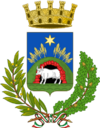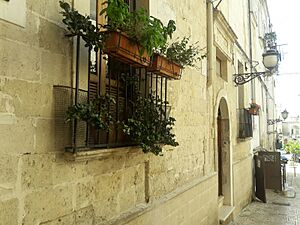Grottaglie facts for kids
Quick facts for kids
Grottaglie
li Vurtàgghie (Sicilian)
|
||
|---|---|---|
| Comune di Grottaglie | ||

Castello Episcopio and the pottery district
|
||
|
||
| Country | Italy | |
| Region | Apulia | |
| Province | Taranto (TA) | |
| Frazioni | Carraro delle Vacche, Paparazio | |
| Area | ||
| • Total | 102.12 km2 (39.43 sq mi) | |
| Elevation | 133 m (436 ft) | |
| Population
(December 31, 2014)
|
||
| • Total | 32,114 | |
| • Density | 314.473/km2 (814.48/sq mi) | |
| Demonym(s) | Grottagliesi | |
| Time zone | UTC+1 (CET) | |
| • Summer (DST) | UTC+2 (CEST) | |
| Postal code |
74023
|
|
| Dialing code | 099 | |
| Patron saint | St. Francis of Geronimo, St. Cyrus | |
| Saint day | January 31 | |
Grottaglie is a town and municipality in southern Italy. It is located in the Apulia region, within the province of Taranto. The town is famous for its long history and traditional pottery. Its name comes from the Latin words Cryptae Aliae, which means "many ravines" or "many caves".
Contents
Exploring Grottaglie's Landscape
Grottaglie is found on the Salento peninsula. This special area divides the Adriatic Sea from the Ionian Sea. The land around Grottaglie has many large and deep natural ditches. These are called ravines, and they are carved into the limestone rock. The oldest part of Grottaglie is actually surrounded by these unique ravines.
A Look Back at Grottaglie's History
People have lived in the Grottaglie area since the Stone Age. The town's name, Grottaglie, comes from the Latin for "many ravines." The oldest part of the town was once a safe place for people. Medieval records call it Casale Cryptalerum. People found shelter in the caves of the ravines to escape raids by Saracen invaders from the coast.
In the 11th century, Norman rulers gave the land of Grottaglie to the Roman Catholic Archdiocese of Taranto. In the 1300s, the church built defenses for the town. These included walls, a fortress called the Archbishop's Castle (Castello Episcopio), and the main church (Chiesa Matrice).
From the 1400s to the 1600s, control over Grottaglie was split. The church handled civil laws, while noble families managed criminal laws. There were often conflicts between these groups. The people also revolted sometimes because of high taxes. This continued until feudalism was ended in 1806. After Italy became a united country, Grottaglie began to grow outside its old medieval walls.
Discovering Grottaglie's Main Sights
Grottaglie has many interesting historical buildings and places to visit:
- Castello Episcopio: This is a huge castle built in the 13th century.
- Chiesa Matrice: This is the town's main church, built in 1379.
- Palazzo Cicinelli: A large building in the Baroque style on the main square. It was once the home of the Dukes of Grottaglie.
- Palazzo Urselli: This palace still has its original Renaissance look. It features a big 15th-century gate and a decorated courtyard inside.
- Palazzo Blasi: Dating back to the 17th century, this building has a Baroque front.
- Palazzo Maggiulli-Cometa: This building is similar in style to Palazzo Urselli.
- Palazzo de Felice: An 18th-century palace that was the family home of the de Felice family.
- San Francesco di Paola: A beautiful Baroque monastery with a cloister (a covered walkway).
- Chiesa del Carmine: This church holds a stone nativity scene from 1530. It was carved by Stefano da Putignano.
Experiencing Grottaglie's Culture
Grottaglie celebrates many traditional and religious events:
- The town honors St. Cyrus on his commemoration day.
- During Easter, old religious groups called confraternities hold processions. These happen during Holy Week. One special Easter ritual involves a procession and pilgrimage by members called “Bubble-Bubble” (Italian: BBubbli BBubbli) through the streets.
Other fun events include:
- The Ceramica nel Quartiere delle Ceramiche exhibition, which showcases local pottery.
- The Mediterranean ceramics contest, where artists compete.
- The promotion of dessert grapes, held in July, August, and September.
- An exhibition and contest for ceramic nativity scenes in December and January.
- Musica Mundi – an international festival of ethnic music in July.
Grottaglie's Economy and Industries
Two important parts of Grottaglie's economy are grapes and the ceramics industry. These have been important since ancient times.
Many old ceramic pieces have been found in the area. They show that pottery making has a long history here. This was helped by the large amounts of clay found nearby. Records from the 18th century show that 42 companies in Grottaglie worked in ceramics. They employed about 5,000 people. Besides ceramics, farming products like olive oil and excellent dessert grapes are also very important.
Grottaglie is also home to Alenia Composite. This factory is part of the Alenia group. It produces parts for the Boeing 787 airplane.
Notable People from Grottaglie
- Antonio Marinari (1605–1689), a Roman Catholic church leader.
- Giuseppe Battista (1610–1675), an Italian poet and writer.
- Francis de Geronimo (1642-1716), an Italian Roman Catholic priest and Jesuit.
- Giuseppe Spagnulo (1936–2016), an Italian sculptor.
- Gianluca Triuzzi (born 1978), an Italian professional football player.
- Giulia Imperio (born 2001), a weightlifter who won a gold medal at the 2022 European Weightlifting Championships.
See also
 In Spanish: Grottaglie para niños
In Spanish: Grottaglie para niños



